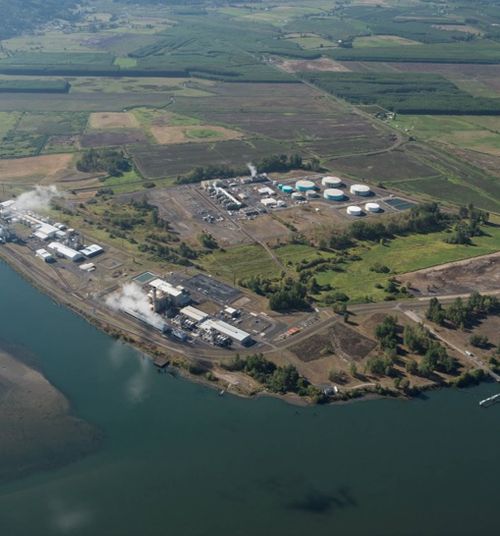Lake Charles Methanol, a proposed $3.24bn blue methanol plant in Lake Charles, Louisiana, will use natural gas-based autothermal reforming technology to produce hydrogen and carbon monoxide, which will then be used to produce 3.6 million tons per year of methanol while capturing and sequestering 1 million tons per year of carbon dioxide.
And if certain conditions are met in final rules for 45V tax credits, the developer could apply for the full benefit of $3 per kg of hydrogen produced. How? It plans to blend carbon-negative renewable natural gas into its feedstock.
“Lake Charles Methanol will be a large consumer of RNG to mitigate the carbon intensity of its hydrogen production,” the firm’s CEO, Donald Maley, said in written comments in response to the IRS’s rulemaking process for 45V.
The issue of blending fractional amounts of RNG into the blue hydrogen production process has emerged as another touchstone issue before the IRS as it contemplates how to regulate and incentivize clean hydrogen production.
The IRS’s proposed regulations do not provide guidance on the use of RNG from dairy farms in hydrogen production pathways such as SMR and ATR, gasification, or chemical looping, but instead only define clean hydrogen by the amount of carbon emissions.
In theory, a blue hydrogen producer using CCUS could blend in a small amount – around 5% – of carbon-negative RNG and achieve a carbon intensity under the required .45 kg CO2e / kg of hydrogen to qualify for the full $3 per kg incentive under 45V.
This pathway, however, will depend on final rules for biogas within 45V, such as which biogas sources are allowed, potential rules on RNG additionality, incentive stacking, and the appropriate carbon intensity counterfactuals.
Furthermore, a potentially separate rulemaking and comment period for the treatment of biogas may be required, since no rules were actually proposed for RNG in 45V on which the industry can comment.
Like the treatment of electricity within 45V, there appears to be some disagreement within Treasury about the role of RNG in the hydrogen production process, with some in the Democratic administration perhaps responding to the view of some progressives that RNG is a greenwash-enabling “sop” to the oil and gas industry, said Ben Nelson, chief operating officer at Cresta Fund Management, a Dallas-based private equity firm.
Cresta has investments in two renewable natural gas portfolio companies, LF Bioenergy and San Joaquin Renewables, and expects RNG used in hydrogen to be a major demand pull if the 45V rules are crafted correctly.
A major issue for the current administration, according to Nelson, is the potentially highly negative carbon intensity score of RNG produced from otherwise vented methane at dairy farms. The methane venting counterfactual, as opposed to a landfill gas counterfactual, where methane emissions are combusted as flared natural gas (therefore producing fewer GHG emissions than vented methane), leads to a negative CI score in existing LCFS programs, which, if translated to 45V, could provide a huge incentive for hydrogen production from RNG.
“Treasury may be struggling with the ramifications of making vented methane the counterfactual,” Nelson said.
Divided views
The potential for this blending pathway has divided commenters in the 45V rulemaking process, with the Coalition for Renewable Natural Gas and similar companies calling for additional pathways for RNG to hydrogen, the promulgation of the existing mass balance and verification systems – as used in LCFS programs – for clean fuels, and the allowance of RNG credit stacking across federal, state, and local incentive programs.
Meanwhile, opponents of RNG blending noted that it would give an unfair economic advantage to blue hydrogen projects and potentially increase methane emissions by creating perverse incentives for dairy farmers to change practices to take advantage of the tax credits.
For example, in its comments, Fidelis New Energy speaks out forcefully against the practice, calling it “splash blending” and claiming it could cost Americans $65bn annually in federal incentives “with negligible real methane emission reductions while potentially driving an increase in emissions overall without proper safeguards.”
Fidelis goes on to state that allowing RNG to qualify under 45V results in a “staggering” $510 / MMBtu for RNG, a “market distorting value and windfall for a select few sizable industry participants.”
Renewables developer Intersect Power similarly notes the potential windfall for this type of project, since the $3 credit would be higher than input costs for blue hydrogen. “Said another way, hydrogen producers using natural gas and blending RNG with negative CI will be extremely profitable, such that it would encourage the creation of more sources of RNG to capture more credits,” according to the comments, which is signed by Michael Wheeler, vice president, government affairs at Intersect.
Stacking incentives
In its initial suggestions from December, Treasury introduced the possibility of limiting RNG that qualifies under 45V from receiving environmental benefits from other federal, state, or local programs, such as the EPA’s renewable fuel standard (RFS) and various state low carbon fuel standards (LCFS).
In response, the Coalition for Renewable Natural Gas said that it does not “believe it is the intent of the Section 45V program to limit or preclude RNG from participation in” these programs.
“In particular, a hydrogen facility utilizing RNG to produce clean hydrogen as defined in Section 45V program should be eligible to claim the resulting Section 45V tax credit, and not be barred or limited from participating in the federal RFS or a state LCFS program, if the RNG-derived hydrogen is being used as a transportation fuel or to make a transportation fuel (e.g. SAF, marine fuel, or other fuel) used in the contiguous U.S. and/or the applicable state (e.g., California), respectively,” the organization wrote.
Various commenters along with the Coalition for Renewable Natural Gas stated that the incentives should work together, and that the EPA has “long recognized that other federal and state programs support the RFS program by promoting production and use,” as Clean Energy Fuels wrote.
Cresta, in its comments, noted that the 45V credit would result in a tax credit of $19.87 per MMBtu of RNG, while almost all potential dairy RNG build-out has a breakeven cost above $20 per MMBtu — in other words, not enough to incentivize the required buildout on its own.
Including this incentive plus environmental credits such as LCFS and RINs could get RNG producers to higher ranges “where you’re going to get a lot of buildout” of new RNG facilities, Nelson said.
In contrast, Fidelis argues that the ongoing RNG buildout utilizing just the existing state LCFS and RFS credits is proof enough that the incentives are working, and that 45V would add an exorbitant and perverse incentive for RNG production.
“To demonstrate the billions in annual cost to the American taxpayer that unconstrained blended RNG/natural gas hydrogen pathways could generate in 45V credits, it is important to consider the current incentive structure and RNG value today with CA LCFS and the EPA’s RFS program, as well as with the upcoming 45Z credit,” Fidelis writes. “Today, manure-RNG sold as CNG with a CI of -271.6 g CO2e / MJ would generate approximately $70 / MMBtu considering the value of the natural gas, CA LCFS, and RFS. The environmental incentives (LCFS and RFS) are 23x times as valuable as the underlying natural gas product.”
In its model, Fidelis claims that the 45V credit would balloon to $510 / MMBtu of value generation for animal waste-derived RNG, but does precisely explain how it arrives at this number. Representatives of Fidelis did not respond to requests for comment.
RNG pathways
As it stands, the 45VH2-GREET 2023 model only includes the landfill gas pathway for RNG, thus the Coalition for Renewable Natural Gas and other RNG firms propose to add biogas from anaerobic digestion of animal waste, wastewater sludge, and municipal solid waste, as well as RNG-to-hydrogen via electrolysis.
According to the USDA, “only 7% of dairy farms with more than one thousand cows are currently capturing RNG, representing enormous potential for additional methane capture,” the coalition said in its comments.
Even the Environmental Defense Fund, an environmental group, supports allowing biomethane from livestock farms to be an eligible pathway under 45V, “subject to strong climate protections” such as monitoring of net methane leakage to be factored into CI scores and the reduction of ammonia losses, among other practices.
However, the EDF argues against allowing carbon-negative offsets of biomethane, saying that “doing so could inappropriately permit hydrogen producers to earn generous tax credits through 45V for producing hydrogen with heavily polluting fossil natural gas.”
First productive use
In issuing the 45V draft guidance in December, the Treasury Department and the IRS said they anticipated that in order for RNG to qualify for the incentive, “the RNG used during the hydrogen production process must originate from the first productive use of the relevant methane,” which the RNG industry has equated with additionality for renewables under 45V.
The agencies said that they would propose to define “first productive use” of the relevant methane “as the time when a producer of that gas first begins using or selling it for productive use in the same taxable year as (or after) the relevant hydrogen production facility was placed in service,” with the implication being that “biogas from any source that had been productively used in a taxable year prior to taxable year in which the relevant hydrogen production facility was placed in service would not receive an emission value consistent with biogas-based RNG but would instead receive a value consistent with natural gas.”
This proposal is opposed by the RNG industry and others planning to use it as a feedstock.
“Instituting a requirement that the use of RNG for hydrogen production be the ‘first productive use’ of the relevant methane would severely limit the pool of eligible projects for the Section 45V PTC,” NextEra Energy Resources said in its comments.
Nelson, of Cresta, called the “first productive use” concept for RNG “a solution in search of a problem,” noting that it’s more onerous than the three-year lookback period for additionality in renewables.
“Induced emissions are a real risk in electricity – they are a purely hypothetical risk in RNG,” Nelson said, “and will remain a hypothetical risk indefinitely in virtually any scenario you can envision for RNG buildout, because there’s just not that many waste sites and sources out there.”
The issue, Nelson added, is that if RNG facilities are required to align their startup date with hydrogen production, the farms where RNG is produced would just continue to vent methane until they can coincide their first productive use with hydrogen.
The Coalition for Renewable Natural Gas argues that the provision “would cause a significant value discrepancy for new RNG projects creating a market distortion, greater risk of stranded RNG for existing projects, added complexity, and higher prices for end-consumers.”
The Coalition proposes, instead, that Treasury could accept projects built prior to 2030 as meeting incrementality requirements “with a check in 2029 on the market impacts of increased hydrogen production to determine, using real world data, if any such ‘resource shifting’ patterns can be discerned.”





